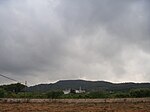Sant Vicenç de Calders
Pages with non-numeric formatnum argumentsPopulated places in Baix PenedèsProvince of Tarragona geography stubsRail junctionsRailway towns in Spain

Sant Vicenç de Calders is a village in the El Vendrell municipality, in the Baix Penedès comarca, Province of Tarragona, Spain. The village was an independent municipality until the 1940s, and is 3.4 km (2.1 mi) SE of El Vendrell. It has a population of just over one hundred. The village is located on a 100-metre-high (330 ft) hill, with a small nucleus of 18th-century houses around the main square and near the church of St Vincent, which is documented since the 11th century and was rebuilt in the 18th century. The location of the village gives good views over Comarruga.
Excerpt from the Wikipedia article Sant Vicenç de Calders (License: CC BY-SA 3.0, Authors, Images).Sant Vicenç de Calders
Carrer de la Riba,
Geographical coordinates (GPS) Address Nearby Places Show on map
Geographical coordinates (GPS)
| Latitude | Longitude |
|---|---|
| N 41.203888888889 ° | E 1.5147222222222 ° |
Address
Carrer de la Riba
Carrer de la Riba
43700
Catalonia, Spain
Open on Google Maps











